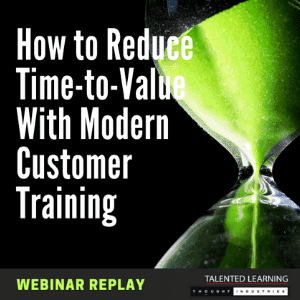
Podcast: Play in new window | Download
Subscribe: Apple Podcasts | Spotify | Amazon Music | Android | iHeartRadio | Blubrry | Email | RSS
WELCOME TO EPISODE 18 OF THE TALENTED LEARNING SHOW!
To learn more about this podcast series or to see the full collection of episodes visit The Talented Learning Show main page.
EPISODE 18 – TOPIC SUMMARY AND GUEST:
Customer success has become an obsession among high-growth companies – especially software-as-a-service (SaaS) vendors. But why is customer success so important? And what kind of educational strategies are most effective?
Today, we discuss these questions and more with expert, Samma Hafeez, VP of Customer Success at Thought Industries, a learning platform provider that helps businesses educate their external audiences.
KEY TAKEAWAYS:
- “Customer success” is more than a buzzword – especially in the subscription software industry, where onboarding and training directly influence product adoption and renewal rates.
- A whole new profession has emerged from the need to help customers succeed. And these roles are changing as rapidly as the customer success function, itself.
- As customer success practices mature, metrics continue to evolve. Organizations are embracing more sophisticated performance measures, as well as predictive models to guide product roadmaps.
Q&A HIGHLIGHTS:
Welcome, Samma. Could you start by telling us a bit about your company?
Sure. Our mission at Thought Industries is to provide the world’s most advanced platform for external learning delivery. We operate in two key markets:
1) Commercial training and professional development organizations, and
2) Businesses that deliver scalable onboarding and training to their customers and customer-facing employees.
So you focus exclusively on the business of learning?
Yes. Ultimately, our customers must drive product adoption, retention and time-to-value among their customers. Think of us as the Wix or Squarespace of online learning. We help businesses bring their external learning vision to life in a fully branded, white-label environment that is modern, sleek, compelling and ready to serve demanding digital consumers.
Plus, our solution is cloud-based. We release new features every two weeks and 50% of our product roadmap is directly influenced by customer input. So there’s always a lot going on.
No doubt. So where does customer success fit-in with cloud-based software?
The customer success role is definitely becoming more popular in the SaaS universe. It’s akin to account management, which historically focused exclusively on customer renewals and churn. But those customer-focused metrics no longer guarantee business success.
With cloud technology taking hold, more businesses are moving to subscription models. At the same time, the cost of acquiring customers has continued to rise. As a result, we’re starting to see more SaaS companies investing in dedicated teams that empower their customers to succeed.
How do customer success teams like yours help users accomplish their goals?
Our role begins once the contract is signed. In the post-sales phase, we help organizations realize value from their investment in our technology and services by driving measurable behavioral change, growth and operational transformation.
In my role as VP of Customer Success, I oversee the teams and the series of onboarding, training and support operations that empower our customers throughout their relationship with us. My performance is measured by my positive influence on customer retention, product adoption and expansion.
That’s an integral role…
It varies from one company to another. But at Thought Industries, I report to the CEO because my role is considered critical to the company’s mission.
Actually, our customer success philosophy is woven into our organizational culture and technology. Almost everyone’s incentives are aligned with what we call a customer impact index to be sure we all remain customer-focused. In today’s highly competitive SaaS environment, I don’t think there’s any other way to operate.
Consumers now have tons of options. They’re more demanding than ever and are not shy about sharing their opinions publicly on social media. They insist on more personalization. It’s no surprise that they prefer to work with providers who are committed to their long-term success.
You’ve been at the forefront of customer success for years. How is this profession evolving?
We’re experiencing exponential growth. Only a few years ago, if you attended a customer success conference, you’d be in a room with maybe 30 to 300 other people. Now thousands and thousands from around the world attend these forums.
Customer success professional backgrounds vary significantly, from traditional client services and consulting roles, to solutions architects and product marketing specialists. It’s a mixed bag that varies by industry.
What customer success metrics should SaaS companies track?
Most executives would probably say churn is an essential metric, and I wouldn’t disagree. But I have a more nuanced perspective.
How so?
I believe customer success metrics should focus on things like time-to-value (TTV), return on investment (ROI) and the specific outcomes your customers need to achieve. These are leading indicators.
In other words, if you help customers drive critical behavior changes, address fundamental business challenges or remove obstacles to growth, you’ll make them look like rock stars. They’re much more likely to reward you with continued business. They’ll also rave about you to others. That brings in more referral business. And that’s what reduces your overall cost to acquire customers.
By focusing on customer outcomes and ROI, you’ll naturally improve related metrics like churn, retention, expansion, which are lagging indicators.
For those who aren’t familiar with these terms, how do you define “churn”? Is it the rate of customer turnover?
Basically yes. But there are many ways to measure churn. For example, a simple “logo churn” rate compares your total number of customers at the beginning and the end of a given time period.
So let’s say on January 1st you have 10 customers, but at the end of the month, only 8 customers remain. Your logo churn is 20% because you lost 2 of 10 customers. You can calculate dollar churn in a similar way. For instance, if you start with $10,000 of monthly recurring revenue and you end with $8,000, then your gross churn rate is also 20%.
So then, what is “time to value”? And what is its relationship with churn?
I like to break time-to-value into short-term and long-term perspectives. In other words, there’s what I call initial time-to-value (or quick time-to-value), which is different from what I call ROI time-to-value.
First, think of initial time-to-value as the number of hours, days, weeks or months from the moment your customer or user approves a contract to the moment they complete a task that matters to them. Or it could be the time it takes to realize value in a way that they couldn’t have without your technology or services.
In a SaaS environment, it’s typically the time it takes for someone who uses your solution to feel like they’ve accomplished something they consider meaningful. These days, it’s essential to help customers minimize that time interval between product activation or delivery and the first moment it demonstrates value.
Could you share some examples?
Sure. Folks who sign-up with us often are consolidating multiple learning delivery systems to a single platform. That, alone, can save them a considerable amount of money and make room in their budget to add headcount or pursue other business priorities.
Another example is the simple migration of content and users from an old, clunky, patchworked learning system to ours. Or it could be as simple as being able to drive actionable reporting that helps their executives make better-informed business decisions.
These scenarios don’t require our customers to be fully trained or onboarded. But the longer it takes for them to feel like they’ve accomplished something meaningful, the more likely they’ll doubt their decision. So to avoid unhappy customers who may walk away, it’s important to minimize that initial time-to-value metric.
Great. So where does the second time-to-value measure come in?
Naturally, ROI time-to-value is a longer time interval. It’s typically the timeframe for your service or technology to deliver on a customer’s core business need. It’s tied to the more strategic reason a customer invests in your solution.
Should time-to-value be measured in hours, days or months? Or is it different for every company?
It depends on the complexity of your product, who you serve and how many people you serve in a customer organization, as well as the technology ecosystem with which your solution interacts.
What is the relationship between time-to-value and onboarding? Does onboarding drive initial time-to-value, or is onboarding a broader concept?
Time-to-value is a measure of success, while onboarding is a process or a program.
Onboarding is not just training – although training is fundamental to an engaging, outcome-oriented experience. But it’s better to think of onboarding as an accumulation of efforts that make it possible for your customers to adopt your product or technology in a meaningful way.
That may require training. But it could also require a series of technology integrations or migrations. Often, a lot of technical legwork is needed to embed a new software product or service into an organization’s native ecosystem workflow.
How do you introduce core software functionality to new customers?
Our strategy for onboarding and educating our customers begins with understanding our audience – who we need to empower. This involves a success planning phase, where we try to understand what the business needs to drive behavioral or process change.
We also decide which key stakeholders need to be involved in that endeavor. Typically, there’s a “super user” or a lead. That person usually needs more education and support than others.
Do you personalize the onboarding experience for each persona?
Yes. Along with our customers, we co-curate a sequence of educational exercises that map to each persona, so everyone has access to a relevant, outcome-centered learning experience.
The best companies figure out exactly who needs to be trained and how much training they actually need. So when you have a new release, rather than trying to train every customer on every feature, you identify the personas for whom the new capabilities are most relevant. Then you improve the way those user segments interact with your system, so they can apply those features more quickly and effectively.
So as you see it, customer success isn’t just about initial time-to-value or even ROI time-to-value. It’s also about collaborative relationships that move customers up the value chain as their business expands and evolves?
Absolutely. For SaaS companies that constantly release new features and functionality, it’s very difficult to scale training as you grow your business. That’s why we see more subscription-based companies looking for customer learning platforms that are robust and flexible.
Our customers shouldn’t have to focus on becoming experts at using our system. We want them to focus on becoming better at doing their jobs. Ideally, our technology melts into their operational environment, rather than standing out from it. This onboarding approach helps support that goal.
FOR MORE QUESTIONS AND COMPLETE ANSWERS, LISTEN TO THE FULL PODCAST NOW!
WANT TO LEARN MORE? REPLAY THIS WEBINAR!
How to Reduce Time-to-Value with Modern Customer Training
Indoctrinating customers as quickly as possible is a smart business move. But exactly when should you start, how fast should you move and how can you be sure that your onboarding process makes a real difference?
Join John Leh, CEO and Lead Analyst at Talented Learning, and Samma Hafeez, Vice President of Customer Success at Thought Industries, as they explain how to accelerate customer time-to-value. You’ll learn:
- What “onboarding” a customer really means
- The critical relationship between onboarding and time-to-value
- How quick wins and clear milestones drive engagement and adoption
- How learning pathways strengthen the onboarding experience
- Tips for metrics that align customer objectives with business priorities
Need Proven LMS Selection Guidance?
Looking for a learning platform that truly fits your organization’s needs? We’re here to help! Submit the form below to schedule a free preliminary consultation at your convenience.
[gravityform id=”18″ title=”false” description=”false”]








